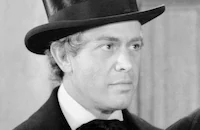Diary of a Madman

Brief Synopsis
Cast & Crew
Reginald Le Borg
Vincent Price
Nancy Kovack
Chris Warfield
Elaine Devry
Stephen Roberts
Film Details
Technical Specs

Synopsis
In 1886, French magistrate Simon Cordier kills a condemned murderer in self-defense, thereby inheriting the Horla, an evil spirit that had possessed his victim. Following several mysterious occurrences, Cordier is visited by the Horla and ordered to kill his pet bird. His will gone, he has no choice but to obey. In an attempt to quiet his nerves, Cordier resumes his hobby of sculpting and falls in love with his model, Odette Duclasse. She neglects to tell the magistrate of Paul, her estranged artist husband, but agrees to run away with him; on the eve of their departure, however, Cordier obeys the Horla's command to murder her. The following morning, unaware of what he has done, Cordier goes to his attic and is horrified to discover Odette's decapitated head resting on the bust he has sculpted. When police arrest Paul for the murder, Cordier maintains silence, even though Jeanne, daughter of art gallery owner Andre D'Arville, pleads with the magistrate to protest her lover's innocence. The Horla then orders Cordier to murder Jeanne, but the reflection of a crucifix awakens him from his murderous trance, and he decides to destroy the evil spirit. Sensing its vulnerability to fire, Cordier awaits the Horla's next visit, then sets his study aflame, killing both himself and his oppressor. As Cordier's will and diary are read, a priest who has been telling the story remarks that the Horla will continue to live wherever evil exists in the heart of man.

Director
Reginald Le Borg
Cast

Vincent Price
Nancy Kovack
Chris Warfield
Elaine Devry
Stephen Roberts
Lewis Martin

Ian Wolfe
Edward Colmans
Mary Adams

Harvey Stephens
Nelson Olmsted

Joseph Ruskin
Dick Wilson
Gloria Clark
George Sawaya
Wayne Collier
Don Brodie
Joseph Del Nostro Jr.
Crew
Norman Breedlove
Ralph Butler
Ellis W. Carter
Marjorie Corso
Victor Gangelin
Daniel Haller
Robert E. Kent
Robert E. Kent
Richard La Salle
Joseph Small
Al Westen
Grant Whytock

Videos
Movie Clip




Hosted Intro



Film Details
Technical Specs

Articles
Diary of a Madman
Master of the arched eyebrow and sardonic smile, Price actually had a long and varied career on stage and screen before he began his successful association with producer Roger Corman in 1960. After a string of hits based on the stories of Edgar Allan Poe, Price was established as the cinema's top horror star, joining the ranks of screen-chiller legends Lon Chaney, Boris Karloff, and Bela Lugosi. In real life, he was an erudite and witty man, a published author, noted gourmet, and art connoisseur.
Nancy Kovack recalled in Science Fiction Stars and Horror Heroes by Tom Weaver that Price "was very respectful and I found that unusual. I knew that I wasn't known, and yet he was very respectful of me and kindly - he didn't have to be....I remember that just before the scene where he kills me with the knife, Vincent Price was tickling me and I was laughing, and I couldn't stop after that!"
Diary of a Madman was directed by Reginald Le Borg, and with a name like that it seemed only natural he would be destined for fame as a purveyor of screen horror. Educated at the University of Vienna, the Sorbonne in Paris, and New York's Columbia University, Le Borg began his directing career in 1943, working in just about every genre from musicals to Westerns to light comedies. While no one would mistake Le Borg as an "auteur" director, he nevertheless had a facility for establishing a sense of place and character motivation, which served him well in two horror pictures, The Black Sleep (1956), starring Basil Rathbone, and Voodoo Island (1957), with Karloff. His last work was So Evil, My Sister (1972), a trashy psychological thriller starring Susan Strasberg and Faith Domergue. Regarding Diary of a Madman, Le Borg later said in an interview with writer Tom Weaver that he felt the picture "came out very well - except for the voice of the Horla, which I wanted to distort quite a bit. We made a test of the voice, the way I wanted it, and (producer) Eddie Small said, 'I can't understand a word!' He wanted the Horla to speak normally, which was wrong."
Despite the low budget, one of the most appealing aspects of Diary of a Madman is Daniel Haller's set design and art direction. Haller had been Corman's chief art director and production designer since the mid-50s, providing the look of Little Shop of Horrors (1960), The Pit and the Pendulum (1961), and The Raven (1963). He turned director with Die, Monster, Die! (1965) and later worked mostly in television.
Producer: Robert E. Kent, Edward Small
Director: Reginald Le Borg
Screenplay: Robert E. Kent, based on stories by Guy de Maupassant
Cinematography: Ellis W. Carter
Editing: Grant Whytock
Art Direction: Daniel Haller
Music: Richard LaSalle
Cast: Vincent Price (Simon Cordier), Nancy Kovack (Odette), Chris Warfield (Paul DuClasse), Elaine Devry (Jeanne D'Arville), Ian Wolfe (Pierre), Stephen Roberts (Captain Robert Rennedon).
C-97m. Letterboxed.
by Rob Nixon & Jeff Stafford

Diary of a Madman
Quotes
Trivia
Notes
The working title of this film is The Horla.

Miscellaneous Notes
Released in United States 1963
Released in United States on Video October 1989
Released in United States 1963
Released in United States on Video October 1989













